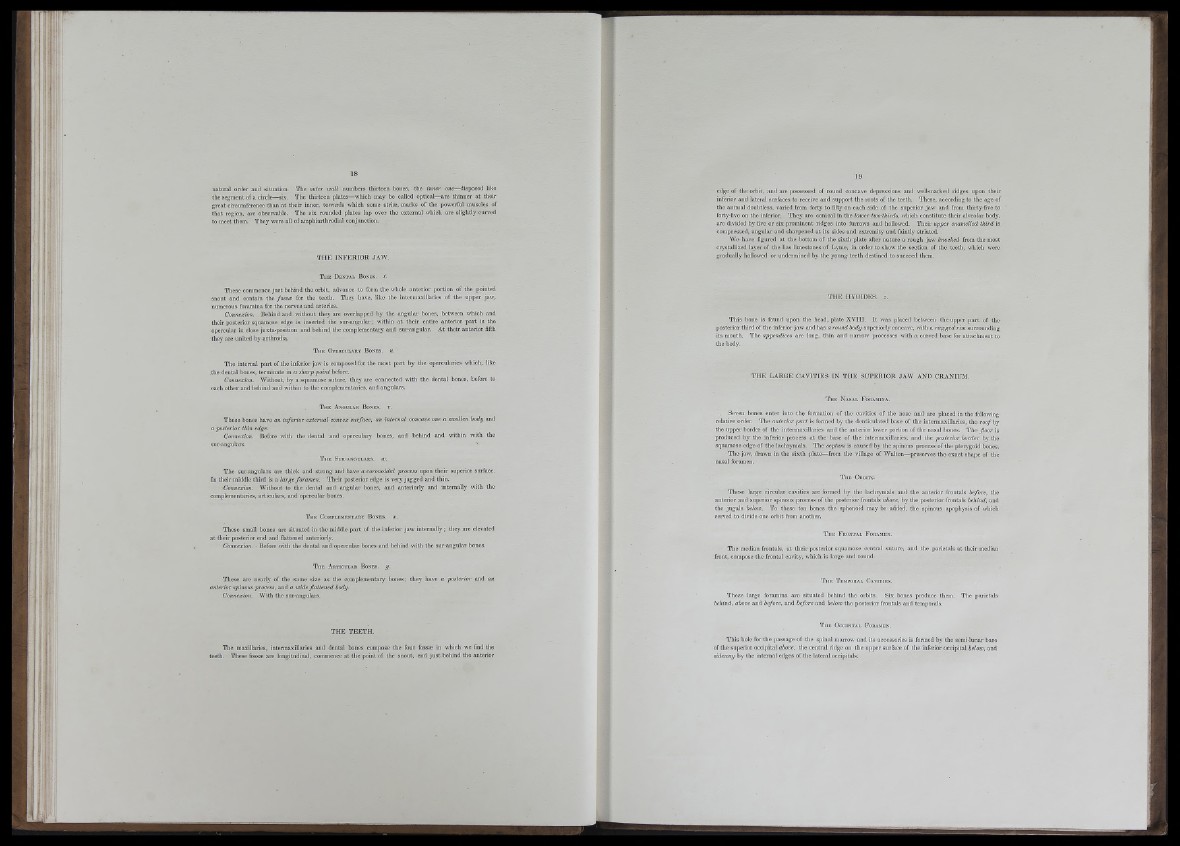
18
natural order and situation, The outer wall numbers thirteen bones, the inner oiie—disposed like
the segment of a circle—six. Tlie thirteen plates—which may be called optical—are thinner at theii'
great circumference ttian at their inner, towards which some striae, marks of tlie powerful muscles of
that region, are observable. The six rounded plates lap over the external which are slightly curved
to meet them. They were all of amphiarthrodial conjunction.
THE INFERIOR JAW.
T he Dental Bones, t.
Tliese commence just behind the orbit, advance to form the wliole anterior portion of the pointed
snout and contain the fosses for the teeth. They have, like the intcrmaxillaries of the upper jaw,
numerous foramina for the nerves and arteries.
Connexion. Behind and witliout they are overlapped by the angular bones, between which and
their posterior squamose edge is inserted the sur-angular; within a t their entire anterior part is the
opercular in close jnxta-position and behind the complementary and sur-angular. At their anterior fifth
they are united by artlirodia.
T h e O p e rc u la ry Bones, u.
The internal jiart of the inferior jaw is composed for the most part by the opercularies whicli, like
the dental bones, terminate in a sharp point before.
Connexion. Without, by a squamose suture, they are connected with the dental bones, before to
each other and behind and within to the complementaries, and angulars.
T he Angular Bones
inferior external convex surface, n internal Tliesc bones have a concave one a swollen body and
a posterior thin edge.
Conne.rion. Before with the dental and operculary bones, and behind and within with the
T he S ur-angulaes. w.
The sur-angulars are thick and strong and have a coronoidal process upon their superior surface.
In their middle third is a large foramen. Their posterior edge is very jagged and thin.
Connexion. Without to the dental and angular bones, and anteriorly and internally with the
complementaries, articulars, and opercular bones.
T h e Com p lejien tary Bones, x .
These small bones are situated in the middle part of the inferior jaw internally; they are elevated
at their posterior end and ilattened anteriorly.
Connexion. ■ Before with the dental and opercular bones and behind with the sur-angular bones.
T he Articular Bones, y.
These are nearly of the same size as the complementary bones; they have a posterior and an
anterior spinous process, and a wide flattened body.
Comiexion. With tlie sur-angulars.
The maxillaries, interroaxillaries and dental bones compose the four fossæ in which we find the
teeth. Those fossae are longitudinal, commence at the point of the snout, end just behind the anterior
, I
1 I
19
edge of the orbit, and are possessed of round concave depressions and well-marked ridges upon their
inferior and lateral surfaces to receive and support tlie roots of the teetli. These, according to the age of
the animal doubtless, varied from forty to fifty on each side of tlie superior jaiv and from thirty-five to
forty-five on the inferior. They arc conical in the lower iwo-thirds, which constitute their alveolar body,
are divided by five or six pi-ominont ridges into furrows and hollowed. Their upper enamelled third is
compressed, angular and sharpened at its sides and extremity and faintly striated.
Wc have figured a t the bottom of tlie sixth plate after nature a rough jaw ¡mocked from the most
ciystallized layer of tlic lias limestones of Lyme, in order to show the section of the teeth, wliich were
gradually hollowed or undermined by ttie young teeth destined to succeed them.
THE HYOÏDES, s.
This bone is found upon the head, plate XVIII, It was placed between the upper part of the
posterior tliird of the inferior jaw and lias a round body superiorly concave, with a ragged rim surrounding
its moutli. The appendices are long, tliin and narrow processes with a curved base for attachment to
the body.
THE LARGE CAVITIES IN THE SUPERIOR JAW AND CRANIUM.
T he Nasal F oramina.
Seven bones enter into tho formation of the cavities of the nose and are placed in the following
relative order. The anterior part is formed by the denticulated base of the intermaxillaries, the roof liy
the upper border of the intermaxillaries and the anterior lou’or portion of the nasal bones. Tlic floor is
produced by the inferior process a t the base of the intermaxillaries, and the posterior border by the
squamose edge of the lachrymals. The septum is caused by the spinous process of the pterygoid bones.
The jaw, drawn in the sixth plate—from the village of Walton—preserves the exact sliape of the
nasal foramen.
T he Orbits.
These large circular cavities are formed by the lachrymals and the anterior frontals before, the
anterior and superior spinous process of the posterior frontals above, by the posterior frontals hehmd, and
the jugals below. To these ten bones tlie sphenoid may be added, the spinous apophysis of which
served to divide one orbit from another.
T iie F rontal F ora;
The median frontals, at their posteric
front, compose the frontal cavity, which is
squamose central suture, and the parietals at their median
argo and roun<l.
T he T emporal Cavities.
These large foramina are situated beliind the orbits. Six bones produce them. The parietals
behind, above and before, and before and below the posterior frontals and temporals.
T he Occipital F oramen.
This hole for the passage of tlic spinal marrow and its accessories is formed by the semi-lunar base
of the superior occipital above, the central ridge on the upper surface of the inferior occipital below, and
sideway by the internal edges of the lateral occipitals.